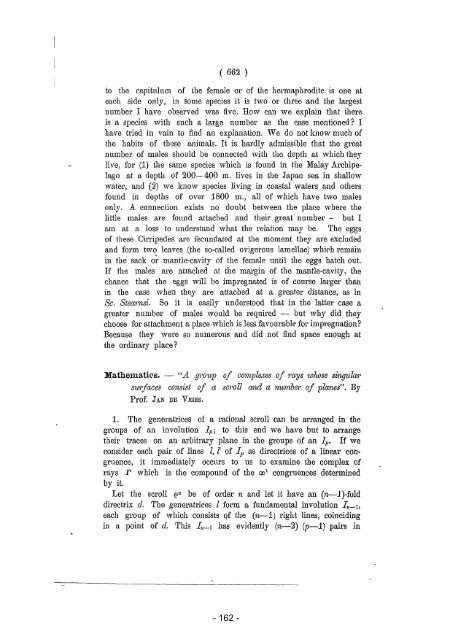Proceedings of the section of sciences - DWC - KNAW
Proceedings of the section of sciences - DWC - KNAW
Proceedings of the section of sciences - DWC - KNAW
You also want an ePaper? Increase the reach of your titles
YUMPU automatically turns print PDFs into web optimized ePapers that Google loves.
( 662 )<br />
to <strong>the</strong> capitnlum <strong>of</strong> <strong>the</strong> female or <strong>of</strong> <strong>the</strong> hel'maphrodite is one at<br />
each side only, in some species it is two Ol' th ree and <strong>the</strong> lal'gest<br />
nnmber I have observed was five. How can we explain that <strong>the</strong>re<br />
is a species with snch a large l1nmber as <strong>the</strong> case mentioned? I<br />
have tried in vain to find an explanation. We do not know much <strong>of</strong><br />
<strong>the</strong> habits <strong>of</strong> <strong>the</strong>se animaIs. It is hardly admissible that <strong>the</strong> great<br />
mlmber <strong>of</strong> mal es should be connected with <strong>the</strong> depth at which <strong>the</strong>y<br />
live, for (1) <strong>the</strong> same species which is fonnd in <strong>the</strong> Malay Archipelago<br />
at a depth <strong>of</strong> 200- 400 m. lives in <strong>the</strong> Japan sea in shallow<br />
water, and (2) we lmow species living in coastal waters and o<strong>the</strong>1's<br />
found in depths <strong>of</strong> over 1800 m., all <strong>of</strong> which have two males<br />
only. A conneclion exists no doubt between <strong>the</strong> place wh ere <strong>the</strong><br />
little males are founc1 attaclled and <strong>the</strong>il' great number - but I<br />
am at a loss to understanc1 wh at <strong>the</strong> relation may be. The eggs<br />
<strong>of</strong> <strong>the</strong>se Cirripedes are fecundated at <strong>the</strong> moment <strong>the</strong>y are excluded<br />
and form two leaves (<strong>the</strong> so-called ovigel'ous lamellae) whirh remain<br />
in <strong>the</strong> sacl{ oi, mantle-cavity <strong>of</strong> <strong>the</strong> female until <strong>the</strong> eggs hatch out.<br />
If <strong>the</strong> males are atrached at <strong>the</strong> margin <strong>of</strong> <strong>the</strong> mantle-cavity, <strong>the</strong><br />
chance that <strong>the</strong> eggs will be impregnated is <strong>of</strong> course largel' than<br />
in <strong>the</strong> case when <strong>the</strong>y are attached at a greater distance, as in<br />
Sc. Steamsi. So it is easily understood that in <strong>the</strong> latter case a<br />
greater number <strong>of</strong> males would be requil'ed - but why dic1 <strong>the</strong>y<br />
choose for attachment a place which is less favourable for imp1'egnation?<br />
Because <strong>the</strong>y were so numerous and did not find space enough at<br />
<strong>the</strong> ordinary place?<br />
Ma<strong>the</strong>matics. - "A gl'OUp <strong>of</strong> comple,ves <strong>of</strong> 1'ays wlwse singula1'<br />
sU1jaces consist <strong>of</strong> a scroll and a mtmber <strong>of</strong> planes". By<br />
Pr<strong>of</strong>. JAN DE VRIES.<br />
1. The generatrices <strong>of</strong> a rational scroIl can be arranged in <strong>the</strong><br />
groups <strong>of</strong> an involution lp; to this end we have but to arrange<br />
<strong>the</strong>ir traces on an arbitrary plane in <strong>the</strong> groups <strong>of</strong> an lp. If we<br />
consic1er each pair <strong>of</strong> lines l, l' <strong>of</strong> lp as directrices <strong>of</strong> a linear congruence,<br />
it immediately occnrs to us to examine <strong>the</strong> complex <strong>of</strong><br />
rays r w hieh is <strong>the</strong> compound <strong>of</strong> <strong>the</strong> 001 congruences determined<br />
by it.<br />
Let <strong>the</strong> seroIl Qn be <strong>of</strong> order n and let it have an (n-l)-fold<br />
dil'ectrix cl. The generatrices 1 form a fundamental involution In-I'<br />
each group <strong>of</strong> which consists Qf <strong>the</strong> (n-1) right lines, coineiding<br />
in a point <strong>of</strong> cl. This 111- 1 has evidently (n-2) (p-1) pairs in<br />
- 162 -

















